ISSN ONLINE(2278-8875) PRINT (2320-3765)
ISSN ONLINE(2278-8875) PRINT (2320-3765)
R. Manoj Prasanth1, S.Raja2, L.Saranya3
|
| Related article at Pubmed, Scholar Google |
Visit for more related articles at International Journal of Advanced Research in Electrical, Electronics and Instrumentation Engineering
The main purposes of Present Automobiles are being developed by more of electrical parts for efficient operation. Generally a vehicle was built with an analogue driver-vehicle interface for indicating various vehicle statuses like speed, fuel level, Engine temperature etc., This paper presents the development and implementation of a digital driving system for a semi-autonomous vehicle to improve the driver-vehicle interface. It uses a PIC based data acquisition system that uses ADC to bring all control data from analogue to digital format and visualize through LCD. This paper presents the development of distance measurement using Ultrasonic sensors which denotes that vehicle’s position from obstacles. The vehicle detects the speed breaker& some critical zones before the certain limitation by tags using RFID module for introducing the new technology of priority based Intelligent Braking System (IBS).
Keywords |
| CAN bus, LCD display, Ultrasonic sensor, controlling sensors, RFID module ,etc. |
INTRODUCTION |
| The protocol was developed aiming at automotive applications. Today CAN have gained wide spread use and is used in industrial automation as well as in automotives and mobile machines. The CAN protocol is implemented in silicon. This makes it possible to combine the error handling and fault confinement facilities of CAN with a high transmission speed. The method used for distributing messages to the right receivers contributes to gaining a good use of the available bandwidth. This requires a simple transmission medium. A common transmission medium is a twisted pair of wires.. The development of CAN began when more and more electronic devices were implemented into modern motor vehicles. Examples of such devices include engine management systems, active suspension, ABS, gear control, lighting control, air conditioning, airbags and central locking. So, it is important that human drivers still have some control over the vehicle. Advanced in-vehicle information systems provide vehicles with different types and levels of intelligence to assist the driver. The introduction into the vehicle design has allowed an almost symbiotic relationship between the driver and vehicle by providing a sophisticated & intelligent driver-vehicle interface through an intelligent information network. This paper discusses the development of such a control framework for the vehicle which is called the digital-driving behaviour, which consists of a joint mechanism between the driver and vehicle for perception, decision making and control. All this means more safety and more comfort for the driver and of course a reduction of fuel consumption and exhaust emissions. The complexities of these control systems, and the need to exchange data between them meant that more and more hard-wired, dedicated signal lines had to be provided. Sensors had to be duplicated if measured parameters were needed by different controllers. Each device can decide if a message is relevant or if it should be filtered. This structure allows modifications to CAN networks with minimal impact. Additional nontransmitting nodes can be added without modification to the network .Fig.1 shows that the CAN bus significantly reduce the wiring. A vehicle was generally built with an analogue driver vehicle interface for indicating various parameters of vehicle status like temperature, pressure and speed etc. A microcontroller based data acquisition system that uses ADC to bring all control data from analogue to digital format is used. Since the vehicle information systems are spread out all over the body of a practical vehicle, a communication module that supports to implement a one stop control of the vehicle through the master controller of the digital driving system. The proposed high-speed CAN bus system solves the problem of automotive system applications, also has a certain practical value and significance. |
| The literature survey of CAN protocol in automation includes the following are, |
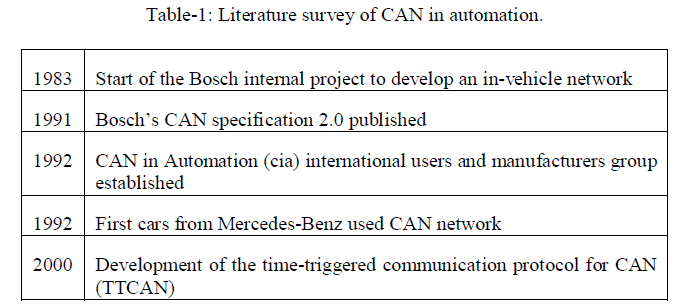 |
| With PIC as the main controller and it makes full use of the high-performance of PIC18f458, high-speed reduction of CAN bus communication control networks and instrument control. so ,as to achieve full sharing of data between nodes and enhance their collaborative work. This system features efficient data transfer among different nodes in the practical applications. And it introduced the distance measurement using ultrasonic sensors. This proposed system provides the intelligent breaking system using RFID module at automatic braking system enabled vehicles. |
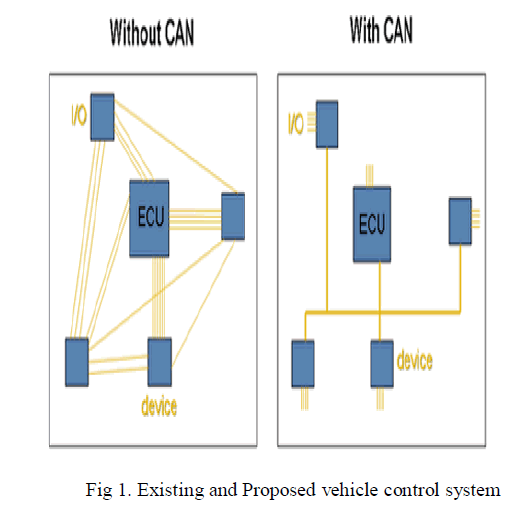 |
II. HARDWARE STRUCTURE |
A. CAN bus |
1. CAN Bus in an Automobile |
| CAN is a LAN (Local Area Network) controller CAN bus can transfer the serial data one by one. Fig 2 shows a typical architecture from an automotive. All participants in the CAN bus subsystems are accessible via the control unit on the CAN bus is a multi-channel transmission system. When a unit fails, it does not affect others. The data transfer rate of CAN bus in a vehicle system is different. For example, the rate of engine control system and ABS is high speed of real-time control fashion of 125Kbps to 1M bps. While the rate of movement adjustment is low-speed with transmission rate of 10 to 125K bps. Others like multimedia systems use medium-speed rate between the previous two. This approach differentiates various channels and increases the transmission efficiency. |
2. CAN Bus for vehicle drive control System |
| A typical drive system with the control unit has electronic fuel injection system, automatic transmission systems, antilock braking system (ABS), airbag systems etc. These units are the core components in a modern car system. They are sensitive for time and closed to the reliability and security of the entire system. As each control unit for real-time requirement is based on the data update rate and the control period varies, in order to meet the real-time requirements of each subsystem, it is necessary to achieve the implementation of public data sharing, such as engine speed, wheel speed, and throttle pedal location. The contents include the completion of speed measurement, fuel measurement, A/D conversion, the calculation conditions, the control actuator and a series of processes. That means the sending and receiving data in 1ms must be completed within the electrical control in order to achieve real-time requirements. Therefore, the data exchange network must be a priority-based competitive mode, and has a very high speed communication fashion. |
3. CAN Bus for accessories control system |
| CAN bus for vehicle system is a leading control network that connects several objects. They are central controller, 4-gates controller, memory modules and other components. There are several items controlled by the CAN bus [2]. They are locker, windows, luggage locker, mirrors and interior dome light. In the case of remote control, it involves the remote control signal receiving and processing the anti-theft and warning systems. |
B. Main control module |
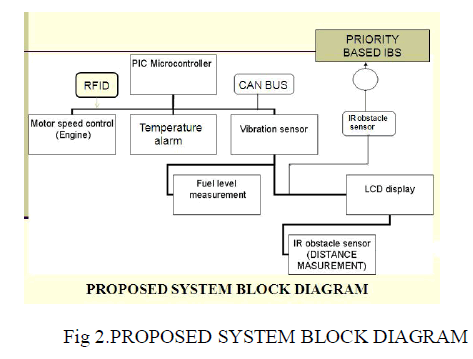 |
1.Peripheral interface controller (PIC) |
| PIC is a family of Harvard architecture microcontrollers made by microchip technology of control peripheral devices, load from main cpu.PIC is equivalent to the automatic nervous system.PIC is very cost effective, and many types of PIC is available for low cost. There is a chance to choose the PIC for suitable application.PIC execute most of instruction in 0.2 micro seconds (or) 5-instructions per microseconds. It has up to 12 independent interferences.PIC is resets by Watchdog timer (WDT).PIC micro controllers has no. Of inbuilt modules like ADC, CAN that increase versatility of microcontrollers. PIC18F458 has Power-on Reset (POR), Power-up Timer (PWRT) and Oscillator Start-up Timer (OST) Watchdog Timer (WDT) with its own on-chip RC oscillator Programmable code protection, Power-saving Sleep mode. |
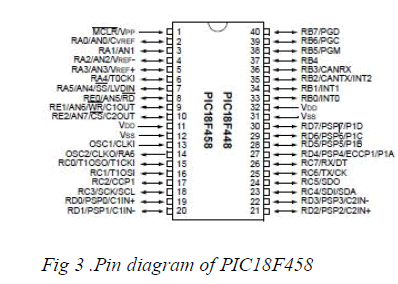 |
2.CAN bus Module Features in PIC18f458: |
| a) Complies with ISO CAN Conformance Test |
| b) Message bit rates up to 1 Mbps |
| c) Conforms to CAN 2.0B Active Spec with: |
| d) 29-bit Identifier Fields |
| e) 8-byte message length |
| f) 3 Transmit Message Buffers with prioritization |
| g) 2 Receive Message Buffers |
| h) 6 full, 29-bit Acceptance Filters |
| i) Prioritization of Acceptance Filters |
| j) Multiple Receive Buffers for High Priority |
| k) Messages to prevent loss due to overflow |
| l) Advanced Error Management Features |
C.OTHER ACCESSORIES |
| 1.LIQUID CRYSTAL DISPLAY (LCD) |
| A liquid crystal display is a special thin flat panel that can let light go through it, or can block the light. (Unlike an LED it does not produce its own light). The panel is made up of several blocks, and each block can be in any shape. Each block is filled with liquid crystals that can be made clear or solid, by changing the electric current to that block. Liquid crystal displays are often abbreviated LCDs. Liquid crystal displays are often used in batterypowered devices, such as digital watches, because they use very little electricity. They are also used for flat screen TV's. They work well by themselves when there is other light around (like in a lit room, or outside in daylight). The LCD uses technology called electro-optical modulation. This means it uses electricity to change how much light passes through it. |
2.ULTRASONIC SENSORS |
| Ultrasonic sensors (also known as transceivers when they both send and receive, but more generally called transducers) work on a principle similar to radar or sonar which evaluate attributes of a target by interpreting the echoes from radio or sound waves respectively. Ultrasonic sensors generate high frequency sound waves and evaluate the echo which is received back by the sensor. Sensors calculate the time interval between sending the signal and receiving the echo to determine the distance to an object. |
3.TEMPERATURE SENSORS (LM-35) |
| LM-35 was Calibrated Directly in ° Celsius (Centigrade).It is Linear + 10 mV/°C Scale Factor0.5°C Ensured Accuracy (at +25°C) .Rated for Full −55°C to +150°C Range. LM-35 is Suitable for Remote Applications. It is Low Cost Due to Wafer-Level Trimming. It Operates from 4 to 30 V and Less than 60-μA Current Drain .It has Low Self- Heating 0.08°C in Still Air. And Low Impedance Output, 0.1 Ω for 1 mA Load. It indicates the low level and high level temperature measurement and automotive ignition level gas exhausting, over heat when vehicle engine/motor speed was increased gradually. |
4.RFID MODULE |
| RFID module- (RFID reader, receiver & transmitter) Vehicle RFID reader. RFID receive & transmitted about 6-8m.Read before viewing distance of such locations that are, for example school zones, speed breakers, hospital zones, etc., in proposed system. When vehicle reaches particular viewing distance of some critical zones then the RFID module can read the RFID tag and sends the control signals to the master circuit or engine control unit for braking process in automatic enabled vehicles. And it monitor the current critical zones in LCD using received signals from RFID tags& RFID module(RFID receiver & transmitter). |
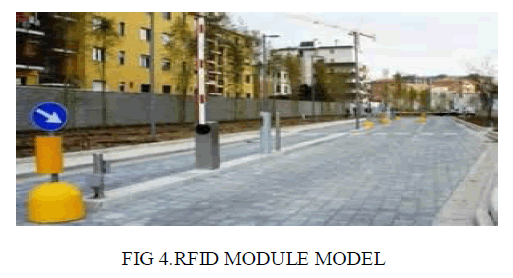 |
5.ECU Testing |
| ECU testing tools from Vector support in broad based implementation of simulation and test environments. Regardless of task in the development process the Vector test tools provide a scalable and re-usable solution from pureSiL simulations to HIL testing to functional tests. |
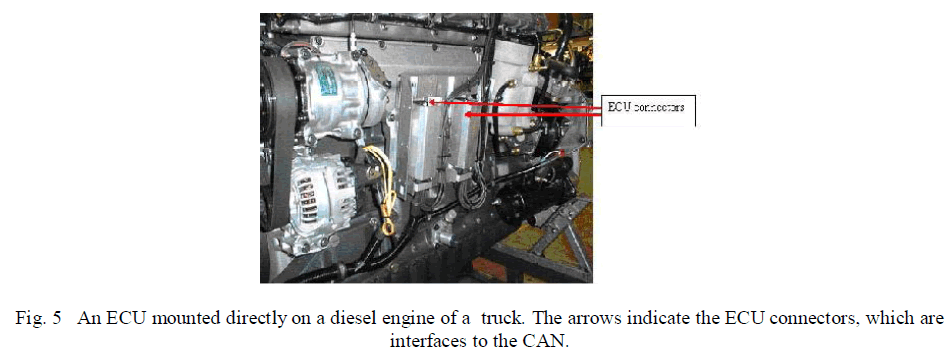 |
III. SOFTWARE STRUCTURE |
| The vehicle control system is programmed using the Embedded C in mikroelectronika for PIC and debugged with PROTEUS simulation. MP Lab IDE PICkit-3 is used for fusing embedded-c coding with CAN IC-18f458. |
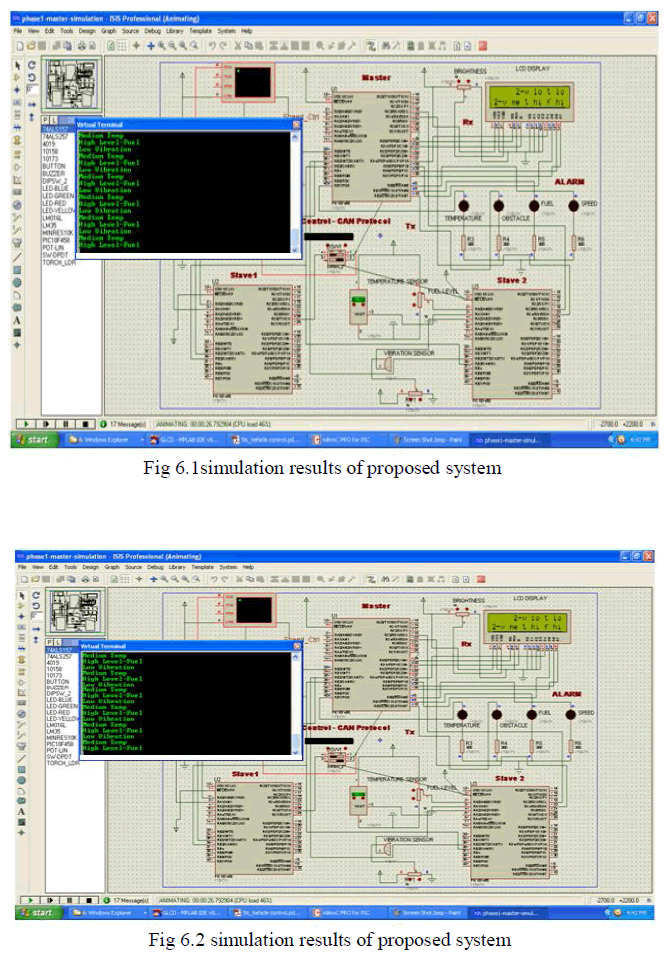 |
IV. WORKING MODEL CIRCUITS AND RESULTS |
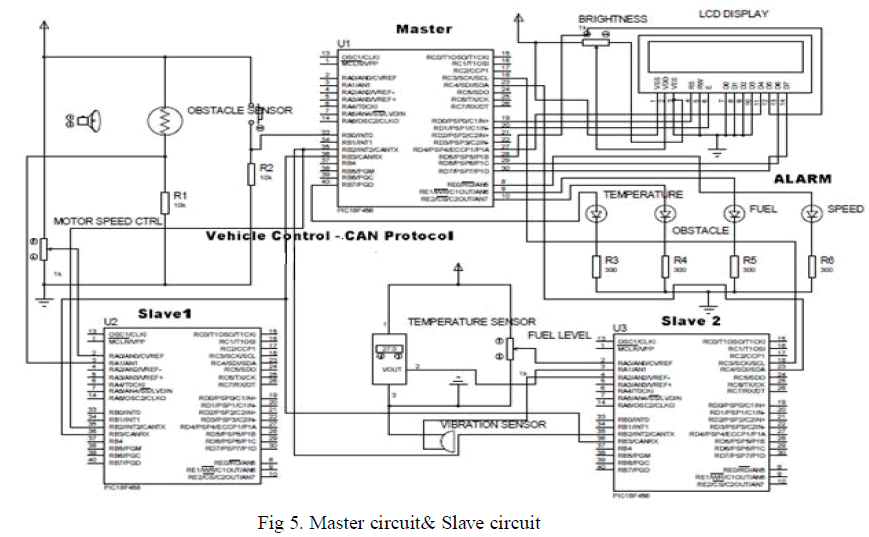 |
| Fig 5 shows the circuit diagram of master node. It consists of PIC18f458, Speed detection unit, LCD, Buzzer. And it shows the slave circuit. This unit consists 2 slave unit named as Slave 1 and Slave 2. Both slave units are PIC18F4580 controller. Power supply for both slave units and other sensors are 5V DC. Slave 1 unit connected with 2 sensors, Motor speed control sensor, Ultrasonic sensor. This sensor generates analogue signal and send to Slave1 controller. Slave 1 controller converting analogue signal into digital signal, then sends to PIC controller through CAN MCP2551 controller. Slave 2 unit connected with following units are, Lightning sensor, Ultrasonic obstacle sensor, Vibration sensor, RFID module. |
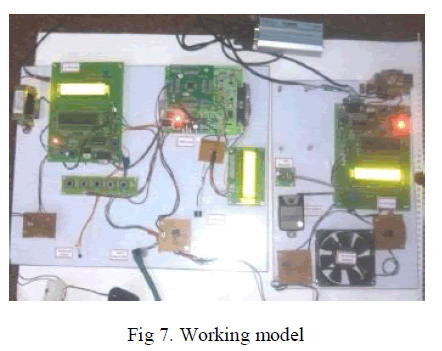 |
| Fig 7 shows the working model of vehicle control system using CAN. |
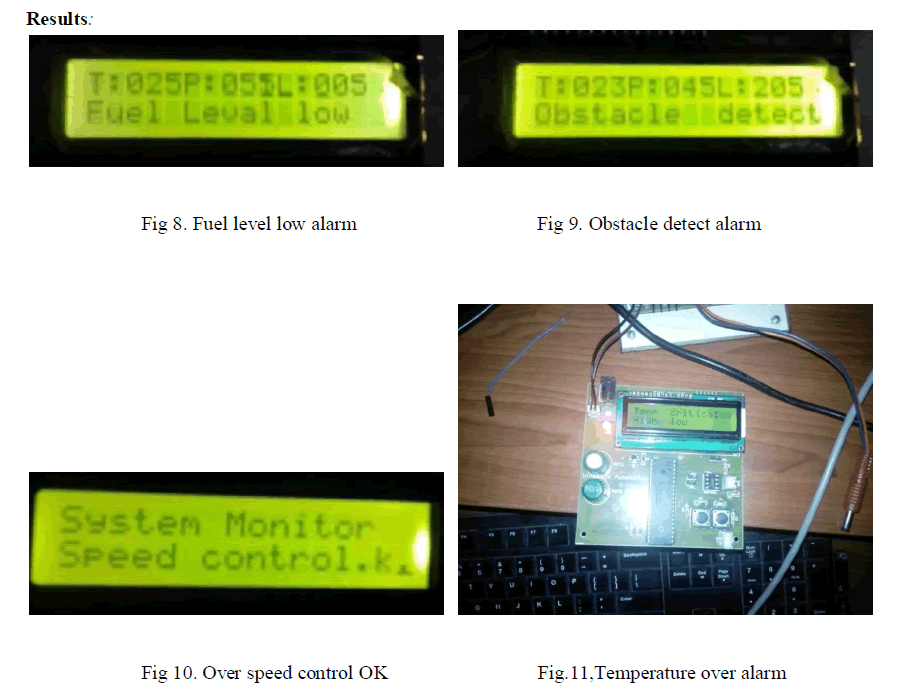 |
| The LCD provided at the driver’s panel displays the various alarms generated with different sensors. Alarm during the various cases like high pressure in tyres, Fuel level low, Obstacles around the vehicles, Over speed etc., |
V. CONCLUSION |
| This project introduces an embedded system with a combination of CAN bus systems. Digital control of the vehicle is an important criterion of modern technology. With the rapid development of embedded technology, highperformance embedded processor is penetrated into the automotive industry, which is low cost, high reliability and other features to meet the needs of the modern automobile industry. The proposed high-speed CAN bus system solves the problem of automotive system applications, also has a certain practical value and significance. With PIC as the main controller and it makes full use of the high-performance of PIC18f458, high-speed reduction of CAN bus communication control networks and instrument control. so ,as to achieve full sharing of data between nodes and enhance their collaborative work. This system features efficient data transfer among different nodes in the practical applications. And it introduced the distance measurement using ultrasonic sensors. This proposed system provides the intelligent breaking system using RFID module at automatic braking system enabled vehicles. |
References |
|